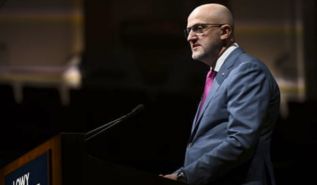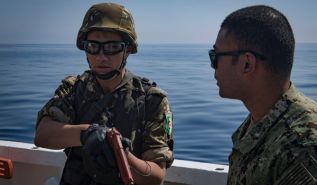بسم الله الرحمن الرحيم
The New Middle East Model: American Domination or Islam and Its Khilafah (Caliphate)?
A Reading in a New Intellectual Project
(Translated)
https://www.alwaie.org/archives/article/20015
Al Waie Magazine Issue No. 471
Thirty-Ninth Year, Jumada I 1447 AH corresponding to October 2025 CE
By: Professor Mohammad Malkawi
In an era when wars intersect with intellectual transformations, and global powers contend over the spirit of the Middle East not just its maps, Professor Mohammad Malkawi presents us with a new intellectual work titled: “The Middle East Model: Seventy Years of American Domination and the Conflict of Visions.” This book comes to open a window into the essence of the conflict not its outward appearances. It proposes new interpretive keys that move beyond the circle of political events to a deep civilizational perspective that connects history, strategy, and thought. It does not suffice with describing what occurred, but attempts to answer the question that research centers and media avoid: Why does the Middle East resist stability? In this work, the author transcends the traditional narrative of political history to a structural analysis of the concept of domination itself, revealing how Western mandate transformed from direct military occupation to a composite system of economic dependency, and cultural and political engineering, exercised by Washington since the end of World War II. What distinguishes the book is that it does not align with mere criticism, but places the reader before a conflict between two opposing models:
An American model governed by the concept of control and domination, and a genuine Islamic model based on the thought of unity and independence. It is a book that rearranges the relationship between thought, politics, and history, and invites the reader to look at the roots of the system, not its results, to discover that what we see today of conflicts and wars is nothing but a reflection of a long-term strategic design shaped by the United States, and that the alternative is not in reaction, but in reformulating the civilizational model itself.
Al-Waie Magazine prepares, with the permission of Allah (swt), to publish selections and analyses from the most prominent thoughts of this book in successive episodes in its upcoming issues, through which it seeks to open an intellectual dialogue about the future of the region between two projects that do not meet: the project of American domination, and the project of the Islamic revival. This book is not merely an academic study, but an intellectual manifesto for an era that is forming, and a call to see the Middle East not as others draw it, but as its sons and daughters see it who realize that history has not yet been written.
The First Article:
The Summary
This article presents a detailed summary of the new Middle East model, clarifying what the American strategy aimed at complete domination over the region has led to, as it elucidates the ongoing conflict between the framework on which the United States relies, which is represented in a model termed the “Four-Plus-Two” model and the alternative Islamic model to which the article refers as “the 1+0 model.” The article places these two models in the context of the historical transformation from the imperial era to the era of domination, tracing the persistence of the American strategic design since the Cold War through the “petrodollar” system in the twentieth century, as it evaluates how emerging ideological currents can herald a shift toward genuine sovereignty emanating from the region.
The Introduction
The Middle East has been, and still is since the end of World War I, a testing ground and a pivot point for global powers, especially after the collapse of the Khilafah in Istanbul. The end of World War II, after 1945 CE, witnessed the collapse of the European empires that worked on colonizing the Middle East and dividing it into small states, that submitted to their control since the end of the First War. Then the United States took on the burden of leadership of post-European imperialism to establish a new model under the title, “The New Middle East Model” (New Middle East Paradigm), which is a framework that ultimately aims to achieve self-stability for the Middle East, in a way that ensures the flow of oil, the continuation of influence, and ideological control.
From Egypt to Iran, Iraq, Syria, the occupying entity, and the Gulf monarchies, this model replaced colonialist guardianship with a new structure of indirect domination, exercised through alliances, coups, and economic dependency. The essence of this domination does not lie in direct invasion, but in continuity from within the region through tools manufactured and prepared from states in the system itself which reduce the cost of domination, increases its impact, and ensures its continuity.
The United States positioned itself as the guardian of the system, its controller, and in constant readiness to suppress any ideological movement that could unify the Muslim World and remove the region from the scope of its control. The result was the creation of a long-term balance, which American sources called: the 4+2 model, meaning four regional pillars, Iran, Turkey, the Kingdom of Saudi Arabia, the occupying entity “Israel”, behind which stand two guarantor states for stability and dependency, the US and Russia. In opposition to this model stands the Islamic alternative rooted in the region for fifteen centuries, which is the 1+0 model, indicating that true stability in the Middle East is only achieved with the establishment of one state with no second, which is the Islamic Khilafah (Caliphate) State, that was abolished in 1924 CE, and work is being done today to restore it to return the leadership of the region to its Ummah, and unify it in a system that guarantees true security and stability for the entire Ummah, not for the Middle East alone. The conflict between the two models manifests continuously, especially during crises and wars in Gaza, Syria, Yemen, Libya, and Algeria.
Post-Imperial Ambitions and the Birth of Domination
After World War II, Washington realized that the traditional empire had become incapable of controlling the political geography of the Middle East. Dean Acheson, the US Secretary of State during President Harry Truman’s era, crystallized the vision for post-European empire, on foundations the most important of which are:
- The economic reconstruction of Europe through the Marshall Plan.
- The institutional engineering of the global order through the Bretton Woods agreements and the NATO alliance.
- The formation of a network of allies subservient to America, and the Middle East was a fundamental axis in that.
Through the Eisenhower Doctrine (1957) and a series of secret interventions since 1950, the United States began its first adventures to displace British influence without bearing its colonialist burdens. So, the beginning was with the Free Officers' Revolution in Egypt (1952) which occurred with covert participation from the CIA. When Washington forced Britain, France, and the usurping Jewish entity to withdraw from Egypt during the Suez Crisis (1956), it was confirmed that imperial power had transferred westward, across the Atlantic to Washington. Decades followed to reinforce American domination in the Middle East through security treaties, military bases, and dollar-denominated oil. After the 1973 war between some Arab states and the occupying entity, the petrodollar system was entrenched as a substitute for gold as a pillar for American monetary sovereignty, which established the economic dimension of the new Middle East model.
Engineering the “Four-Plus-Two” Framework
The concept of “Four-Plus-Two” which was formalized in the report “The New Geopolitics of the Middle East” issued by the Brookings Institute in 2019, summarizes the American strategy in distributing the management of regional stability among four pivotal states with final oversight by the United States and Russia.
These states were chosen based on precise calculations by American decision-makers:
Turkiye: A bridge between the strategic depth of NATO and the Muslim World, with a hybrid authority, secular-Islamic, that balances between the two identities, and possesses an important economic dimension.
Iran: Despite its rhetorical hostility to America, it remains an indispensable regional actor, as shown by its stances towards Afghanistan, Iraq, and Syria in ways that serve the American project.
The Kingdom of Saudi Arabia: By virtue of its custodianship of the Two Holy Mosques, it plays the role of ideological containment through promoting a non-politicized Deen, protecting the petrodollar system, and supporting the financial and geopolitical stability system.
The Occupying Jewish Entity: A forward military base for Western military and intelligence projection, tolerated for its expansionist ambitions in exchange for its sensitive role.
Including Russia as a participating guarantor adds multilateral legitimacy, and hides American unilateralism under the mask of international balance. This design aims to marginalize Europe and China, and enable Washington to manage crises outside the constraints of the United Nations. The years have proven, especially during the Syrian Revolution (2011–2024) that Russia did not deviate from the American line, but performed its role “with complete professionalism,” and left the field when its mission ended.
Contradictions of the Framework and the Failure of the Alleged Stability
However, the contradictions of the “Four-Plus-Two” framework are deep and fundamental. Each of its pillars proceeds along an ideological path that is different from the others. In addition, the policies of occupation and repeated wars waged by the Jewish entity undermine the stability that the system claims to guarantee. The Gaza war, with its disastrous consequences for civilians, exposes the moral and strategic bankruptcy of a model that equates security with submission and domination.
The Islamic Vision of “One-Plus-Zero”
In contrast, the “One-Plus-Zero” model assumes that true stability can only emanate from a unified and genuine Islamic political entity, represented in the Islamic Khilafah state. This model rejects the fragmentation imposed from outside, affirms that sovereignty belongs to Allah (swt)alone, not to the nationalistic secular regimes, whose borders were drawn by colonialism.
This vision, promoted by thinkers like Taqiuddin an-Nabhani and movements like Hizb ut Tahrir directs toward establishing a state based on the Noble Quran and Prophetic Sunnah, with codified institutions in ruling, economy, and judiciary. This argument is not romantic or utopian, but structural and realistic; for unity, not balance of powers, is what produced centuries of civilizational cohesion in the Middle East before 1924. Since the fall of the Khilafah, political fragmentation has led to the constant need for foreign intervention.
For the supporters of this model, the continuation of injustice, occupation, and economic dependency confirms the inevitability of revival, as every cycle of war or humiliation nourishes the belief in the near return of the Khilafah, especially in the face of the current regimes’ inability before crises like the Gaza war (2023 – 2025). Therefore, the “One-Plus-Zero” model represents a counter-ideology, and a prediction of a systemic rift that will inevitably lead to the failure of the “Four-Plus-Two” arrangement.
Domination and the Illusion of Stability
The chapters of the book “The New Middle East Model: Four-Plus-Two or One+Zero” clarify the mechanism of submission of Egypt, Iran, Iraq, Syria, and Saudi Arabia to American domination, where the pattern repeats in different forms:
- The United States’ support for submissive armies,
- Manipulation of ideological rivalries,
- And substituting a facade of formal sovereignty for overt colonialism.
America has used one method for domination with variation in approaches: from Copeland’s secret involvement in Cairo to winning military leaders through bases and arming in Iran, then direct occupation in Iraq, then winning over kings and princes in the Gulf. In all cases, the result was one: fixing American influence with the least cost and greatest effect.
Despite America making for the Jewish occupying entity a pivotal role within the four states preserving stability, the Jewish entity remained the final obstacle before the completion of the American model. For despite being a Western forward military base, it is considered the greatest source of instability, due to its settler expansionist nature, its insistence on nuclear and military domination, and its repeated wars that fail any long-term stability. That was proven after what was called the “Peace Conference” aimed at ending the Gaza war, as the Trump administration was forced to send Vice President Vance, the special envoy Steve Witkoff, and Jared Kushner to Netanyahu only a week after signing the agreement, realizing that the Jewish entity keeps the region always on a hot plate, serving its projects in expansion, displacement, and strategic superiority, especially in the Iranian nuclear file. Instead, the Jewish entity directed a strike at the negotiation delegation in Qatar when it sensed that an imminent agreement might be concluded if negotiations continued.
Towards a Post-Petrodollar Middle East
After half a century of dollar domination under the cover of Saudi oil and the OPEC system, the pillars of this system began to erode due to: massive inflation in global dollar liquidity, the shift in energy sources toward alternatives, the decline in the need for oil, campaigns to abandon the dollar led by BRICS countries, in addition to popular anger from the genocide in Gaza.
All of that undermines the moral and material foundations of American sovereignty, and added to that is the danger of the war in Ukraine and the possibility of its expansion, which may shift Washington’s priorities from the Middle East to broader fronts. This is likely to inflict a setback on the American project in the region from which there may be no return.
In this growing international vacuum, the “One-Plus-Zero” model gains increasing resonance, as a protest model and a political alternative at the same time, and represents a form of ending ideological colonialism.
Nevertheless, achieving the Khilafah model faces enormous barriers, which are:
- The entrenched structures of nation-states,
- The suppression of Islamic movements,
- The absence of unified leadership,
- The continued preoccupation with wars keeps the popular base far from radical solutions.
The Conclusion
“The New Middle East Model” calls readers to look at the region, not as a collection of scattered conflicts, but as an evolutionary conflict between domination, the Western model, and authenticity the Islamic model of Khilafah, between control and unity, between stability and justice.
The “Four-Plus-Two” system has achieved remarkable resilience, but its sustainability depends on a constant imbalance and a continuous moral decline. Indeed, its success in preventing revolutionary transformation is precisely what guarantees repeated violence.
In contrast, the “One-Plus-Zero” model expresses a deep yearning for sovereignty to Allah (swt) and moral cohesion. Whether it is realized as a political state or remains a guiding example, its rise expresses the exhaustion of the ummah's patience with imported and sterile models.
It is not a question of: Which of the two models will prevail? Instead: Can the Middle East transcend the dialectic of domination and challenge, in order to build a just system order in its civilizational origins?
If the Twentieth Century was the era of empire and domination, then the Twenty-First century may be the era of thoughts and models, as tools for liberation (tahrir) and reshaping the world. In this sense, the New Middle East Model is a call to awareness: to the realization that geopolitical stability divorced from moral legitimacy cannot last, and that the future of the region – indeed the entire world order – will be determined according to: which hand will ultimately hold the mantle of legitimacy. To America and its tools of domination, or to Islam and its single state (Khilafah)?
[وَٱللَّهُ غَالِبٌ عَلَىٰٓ أَمۡرِهِۦ وَلَٰكِنَّ أَكۡثَرَ ٱلنَّاسِ لَا يَعۡلَمُونَ]
“And Allah (swt)is predominant over His affair, but most of the people do not know” [TMQ Surah Yusuf: 21].




